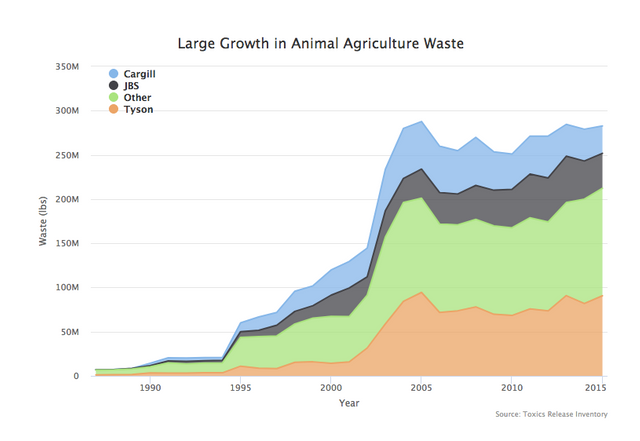A previous post of mine mistakenly measured waste produced by slaughterhouses and meat processing facilities rather than the livestock farms themselves. What follows is an updated version of this post and code that measures livestock as intended, and contains additional analysis.
Visualizing industrialization by measuring poop.
Animal agriculture is increasingly industrial, as demonstrated by a decreasing amount of small farms, and a steady increase of the percentage of animals on factory farms.
Another way to measure the industrialization of animal agriculture is to chart the waste produced by industry facilities. Using data from the Environmental Protection Agency's Toxics Release Inventory (TRI) Program, I charted the past 30 years in animal agriculture waste. These estimates measure the amount of waste that has been released or treated at the facility where it was created. In animal agriculture, this often involves spraying waste or depositing it in a septic pit.

Waste produced by industrial animal agriculture facilities has increased in the past 30 years. This trend has taken place despite the demand and consumption of meat having seen a reasonable decline during this time period. It is also noteworthy that while this chart represents hundreds of companies, just 3 of them make up the majority of waste produced by animal agriculture. The 2002 boom in waste can in part be explained by the 2002 Farm Bill which accounts for most of the $133 billion in subsidies given to animal-feed, tobacco and cotton farms between 1995 and 2010.
This increase in waste production and industrialization is concerning due to the industry practices of large-scale operations that abuse animals, harm workers, threaten public health, damage the health of poorer communities, and heavily contribute to climate change. There is too much waste, and not enough waste management.
The code used to make these graphs is on GitHub.

The increase of industrial animal agriculture and a decline to small farms is a big alarm to the society. While we need sustainable and ensured productivity of meat in the market, one can testify that we're shifting to an economic imbalance where in the future, the prices can easily be controlled by them.
A typical example in our country will be the oil and communication industry. They can just do what they want because only few are in control and has the power to dictate prices.
Well, I hope the data above constitute to a positive implication to the community.
Downvoting a post can decrease pending rewards and make it less visible. Common reasons:
Submit
Congratulations @somethingburger! You have completed the following achievement on the Steem blockchain and have been rewarded with new badge(s) :
Click on the badge to view your Board of Honor.
If you no longer want to receive notifications, reply to this comment with the word
STOPDownvoting a post can decrease pending rewards and make it less visible. Common reasons:
Submit
Congratulations @somethingburger! You have completed the following achievement on the Steem blockchain and have been rewarded with new badge(s) :
Click on the badge to view your Board of Honor.
If you no longer want to receive notifications, reply to this comment with the word
STOPDownvoting a post can decrease pending rewards and make it less visible. Common reasons:
Submit